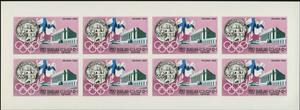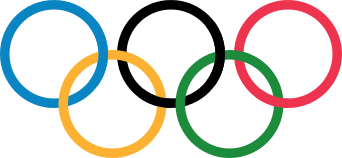Full Pane: Helsinki (Sharjah 1968)
Helsinki (Sharjah 1968)
10 October (Sharjah ) within release History of the Olympic Games goes into circulation Full Pane Helsinki face value 8*50 Qatari dirham
| Full Pane Helsinki in catalogues | |
|---|---|
| Colnect codes: | Col: AE-SH 1968.10.10-09c |
Full Pane is horizontal format.
Also in the issue History of the Olympic Games:
- Stamp - London face value 25;
- Stamp - Helsinki face value 50;
- Stamp - Melbourne face value 75;
- Stamp - Rome face value 1.50;
- Stamp - Tokyo face value 3;
- Stamp - Mexico face value 4;
- Souvenir Sheet - Mexico face value 5;
- Stamp - Mecixo face value 4;
- Stamp - Tokyo face value 3;
- Stamp - Helsinki face value 50;
- Stamp - London face value 25;
- Stamp - Rome face value 1.50;
- Stamp - Melbourne face value 75;
- Stamp - Mexico face value 5;
- Full Pane - Helsinki face value 8*50;
- Full Pane - Helsinki face value 8*50;
- Souvenir Sheet - Helsinki face value 50;
- Full Pane - London face value 8*25;
- Full Pane - London face value 8*25;
- Souvenir Sheet - London face value 25;
- Full Pane - Melbourne face value 8*75;
- Full Pane - Melbourne face value 8*75;
- Souvenir Sheet - Melbourne face value 75;
- Full Pane - Mexico face value 8*4;
- Full Pane - Mexico face value 8*4;
- Souvenir Sheet - Mexico face value 4;
- Stamp - Mexico face value 5;
- Souvenir Sheet - Mexico face value 5;
- Full Pane - Rome face value 8*1.50;
- Full Pane - Rome face value 8*1.50;
- Souvenir Sheet - Rome face value 1.50;
- Full Pane - Tokyo face value 8*3;
- Full Pane - Tokyo face value 8*3;
- Souvenir Sheet - Tokyo face value 3;
Full Pane Helsinki it reflects the thematic directions:
A building or edifice is a structure with a roof and walls standing more or less permanently in one place, such as a house or factory. Buildings come in a variety of sizes, shapes and functions, and have been adapted throughout history for a wide number of factors, from building materials available, to weather conditions, to land prices, ground conditions, specific uses and aesthetic reasons. Buildings serve several needs of society – primarily as shelter from weather, security, living space, privacy, to store belongings, and to comfortably live and work. A building as a shelter represents a physical division of the human habitat (a place of comfort and safety) and the outside (a place that at times may be harsh and harmful).
A flag is a piece of fabric (most often rectangular or quadrilateral) with a distinctive design that is used as a symbol, as a signaling device, or as decoration. The term flag is also used to refer to the graphic design employed, and flags have since evolved into a general tool for rudimentary signalling and identification, especially in environments where communication is similarly challenging (such as the maritime environment where semaphore is used). National flags are patriotic symbols with varied wide-ranging interpretations, often including strong military associations due to their original and ongoing military uses. Flags are also used in messaging, advertising, or for other decorative purposes. The study of flags is known as vexillology, from the Latin word vexillum, meaning flag or banner.
The modern Olympic Games or Olympics (French: Jeux olympiques) are leading international sporting events featuring summer and winter sports competitions in which thousands of athletes from around the world participate in a variety of competitions. The Olympic Games are considered the world's foremost sports competition with more than 200 nations participating. The Olympic Games are held every four years, with the Summer and Winter Games alternating by occurring every four years but two years apart.
Sport is a form of physical activity or game. Often competitive and organized, sports use, maintain, or improve physical ability and skills. They also provide enjoyment to participants and, in some cases, entertainment to spectators. Many sports exist, with different participant numbers, some are done by a single person with others being done by hundreds. Most sports take place either in teams or competing as individuals. Some sports allow a "tie" or "draw", in which there is no single winner; others provide tie-breaking methods to ensure one winner. A number of contests may be arranged in a tournament format, producing a champion. Many sports leagues make an annual champion by arranging games in a regular sports season, followed in some cases by playoffs.




